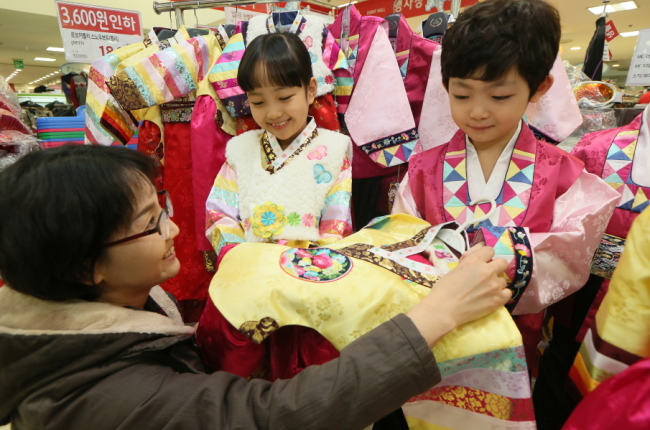[Weekender] Korea strives to revive fading interest in traditional clothes
By Lee Woo-youngPublished : Jan. 24, 2014 - 20:34

Han Hyun-young, a 29-year-old office worker in Seoul, had a hanbok custom-made for herself when she got married in 2011. But she has worn the traditional Korean clothes only twice ― on her first visit to her in-law’s house after her honeymoon and on her sister-in-law’s wedding day.
“I wore it because I had to. I wouldn’t wear it if I didn’t have to,” she said.
Han is not the only one feeling reluctant to wear a hanbok on special occasions. As hanbok are no longer a daily outfit for most Koreans, fewer people are willing to wear it even on occasions when wearing a hanbok is considered appropriate or tradition calls for it.
“I feel overly dressed up and like I stand out among others who are in their everyday clothes,” said Han. She said she wished she rented a hanbok or borrowed from her married friends rather than keep her 500,000 won gown in her closet for the rest of the year.
Lunar New Year’s Day used to be a day when family members took out their best hanbok or had a new one made. The “seolbim,” which refers to the hanbok worn on the holiday, was distinguished from other everyday hanbok with bright colors to wish for good luck in the new year.
But wearing a hanbok is becoming a fading tradition in the lives of Koreans with fewer people wearing it or visiting hanbok shops for new ones.
“I haven’t seen a single customer come for a new hanbok for Lunar New Year’s Day this year. We’ve had a few for other occasions,” said Lee Hye-soon, president and designer of the hanbok brand Damyeon.
Yoon Hee-jae Hanbok Shop in Gwangjang Market, the biggest hanbok market in Seoul, has received several customers who came to have their hanbok made for the Lunar New Year’s Day. But the shop owner admits that most of the clothes ordered have been either for children or the elderly.
“Because people don’t wear hanbok as a daily outfit anymore, more people feel uncomfortable with the idea of wearing it even on special days like Lunar New Year’s Day. More people are unwilling to buy a hanbok because they know they won’t be able to wear it often,” said Yoon Hee-jae, who runs her eponymous brand at the market.
There are efforts to revive Koreans’ interest in hanbok. Royal palaces in Seoul offer free admission throughout the year to those wearing a hanbok. But according to palace staff, few people visit palaces in hanbok although they have been promoting wearing them for many years.
Jongno District Office made it mandatory for its officials to wear hanbok to work once a month. Initiated by the district mayor, the Hanbok Day event encourages staff to wear hanbok by announcing the best hanbok dresser once a month.
“I was hesitant to wear it first when I was told to wear at work. But when I actually tried it on, it was different. It looks beautiful and your attitude changes,” said Yoon Jeong-suk, a manager in the office’s public relations division.
According to district officials, hanbok brightened the atmosphere of the civil complaint office as citizens who come to file complaints offer a word of praise to staff rather than getting angry at them.
Choi Jung-ryeon, director of the public relations team, hadn’t owned a hanbok before and had to buy two for the monthly Hanbok Day.
“Hanbok is a traditional costume for Koreans worn for thousands of years, but when I wore it at work, I wasn’t really comfortable in it at first. The wide sleeves bothered me when I had to use office utilities,” he said. “But it drew good responses from citizens. And it helps promote Gwangjang Market.” Gwangjang Market is located in Jongno district.
Lee Hye-soon, who has worn hanbok daily for more than 20 years, said the reason people are hesitant to wear it is that they are uncomfortable in the clothes. So in order to wear it more frequently, they should have their hanbok made to fit their body, she said.
“Wearing something new is always an uncomfortable experience for anyone, whether it’s Western clothes or shoes. But if you wear it often, you get used to it and know how to move comfortably in the clothes. Because people don’t wear hanbok every day, their first time is always difficult. When you wear it again and again, you get comfortable with the clothes physically and psychologically,” she said.
“It starts with wearing it on a special day like Lunar New Year’s Day.”
By Lee Woo-young (wylee@heraldcorp.com)












![[Today’s K-pop] BTS pop-up event to come to Seoul](http://res.heraldm.com/phpwas/restmb_idxmake.php?idx=644&simg=/content/image/2024/04/17/20240417050734_0.jpg&u=)




![[KH Explains] Hyundai's full hybrid edge to pay off amid slow transition to pure EVs](http://res.heraldm.com/phpwas/restmb_idxmake.php?idx=652&simg=/content/image/2024/04/18/20240418050645_0.jpg&u=20240419100350)

![[Today’s K-pop] Zico drops snippet of collaboration with Jennie](http://res.heraldm.com/phpwas/restmb_idxmake.php?idx=642&simg=/content/image/2024/04/18/20240418050702_0.jpg&u=)